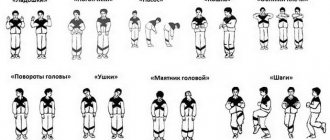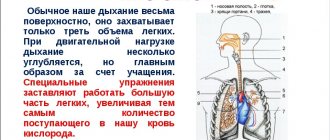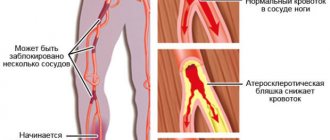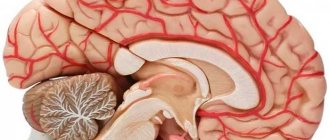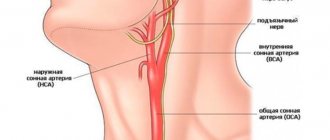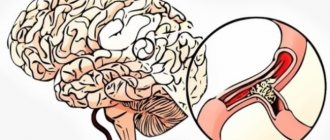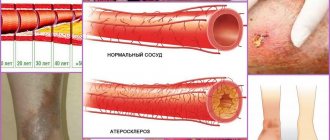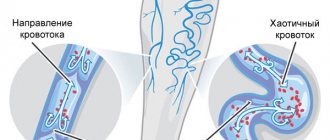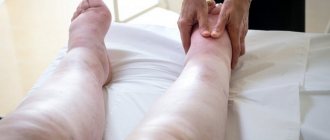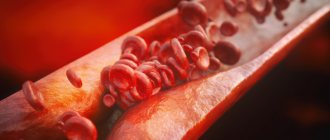Atherosclerotic vascular damage occurs even in infancy; in adulthood it is diagnosed in half of the population, and by old age the incidence reaches almost 100%.
Will exercise therapy for atherosclerosis help reduce the risk of dangerous complications? If so, what kind of therapeutic exercises are used to normalize the condition of the walls of blood vessels, and in what situations is it indicated?
Is it possible to play sports with atherosclerosis?
Every competent doctor will answer that doing physical exercise is not only possible, but also necessary.
- When performing active movements, blood vessels dilate , which restores the speed of blood flow in them, while the tissues they feed are fully saturated with oxygen.
- Muscles working during physical activity get rid of spasms caused by narrowing of the lumen of the arteries by atherosclerotic plaques and impaired nutrition of nerve fibers.
- In heated tissues, not only does blood supply increase , but also vessels that do not work at rest (collaterals) open, which are of great importance for compensating for lack of nutrition in severe atherosclerosis.
- Cardio exercises help to enhance the contractility of the myocardium, gradually normalizing the rhythm and increasing the endurance of the heart .
- Breathing exercises enrich the blood with oxygen, speeding up metabolism and thereby reducing the level of “bad” cholesterol deposited in the walls of blood vessels.
The main thing is that classes do not occur at the time of exacerbation of complications caused by atherosclerosis (heart attack, micro-stroke, acute disturbance of blood flow in the limbs or intestines). But after an acute period of pathology, you shouldn’t hesitate with exercise therapy either: the speed of restoration of body functions depends on it.
The method of treating and preventing atherosclerosis using the patient’s independent active movements is called kinesitherapy .
In the case of vascular pathology, aerobic exercises - performed in fresh, clean air - are especially useful. During training, you should breathe deeply, exhaling for exertion and inhaling for relaxation.
Exercises in the gym are not suitable for everyone: they are indicated as a prevention of atherosclerosis or in its initial stages. The doctor will select the appropriate complex on an individual basis, depending on the degree of vascular damage.
Therapeutic gymnastics is performed:
- after a short quiet warm-up and subsequent muscle stretching;
- without significant weighting agents (without them or with low weight);
- at a slow pace without jerks or sudden movements;
- regularly, with monitoring of well-being and pulse.
The first workouts should begin with minimal loads and optimal time, causing only a feeling of slight fatigue, and not a heartbeat failure, shortness of breath, or strong pulsation of blood vessels in the head.
After getting used to it, the load needs to be rationally increased. The tempo will be determined by a physical therapy specialist, based on the indicators of pulse, pressure and respiratory rate during the demonstration exercise.
Symptoms
At the beginning of the development of atherosclerosis of the lower extremities, the calf muscles hurt, the pain is similar to a burning sensation, or swelling from the inside and comes with contractions. There may be no pain, but you can feel that your legs quickly get tired during exercise - this is a consequence of ischemia of the skeletal muscles. But after this fatigue, after some time, severe pain still occurs, which initially occurs when walking, and disappears after rest. After some time, pain may appear even at night; it is accompanied by muscle cramps in the calves.
If atherosclerosis of the lower extremities is not treated, the pain will become stronger, the trophism (structure and functionality that depends on nutrition) of the tissues undergo changes for the worse - nails become brittle, the skin becomes pale, shiny and dry, even flaking. The last stage of the disease is associated with the formation of ulcers and tissue death (necrosis), sometimes gangrene occurs, in which the limb must be amputated.
There are no treatments for atherosclerosis, so the disease must be detected early and its development stopped. This is helped by therapeutic exercises, physical procedures, as well as a special diet, which, with the help of a special diet and the presence of healthy food, helps improve the condition of blood vessels, blood circulation and nutrition of leg tissues. Herbal medicine and honey therapy help in those volumes whose effectiveness has been confirmed by official science.
Exercises for atherosclerosis of the lower extremities
The vessels of the legs are the easiest to train, because in addition to accelerating blood flow, increasing pressure in them and increasing oxygenation, they are affected by the mechanical force of contracting muscles. Therefore, correctly selected exercise therapy helps even with obliterating atherosclerosis (partial or almost complete blockage) of the vessels of the lower extremities.
It is best to start gymnastic movements while lying on your back. When they are performed, the walls of the arteries are affected, venous outflow occurs, eliminating stagnation of blood and lymph in the vessels, and the abdominal press is tensed. These include:
- flexion-extension of the ankle joints of the legs raised vertically (first one leg, then the other, and then both at the same time);
- similar flexion-extension of the legs at the knee joints;
- “bicycle” with hip joints bent 90°;
- “scissors” with spreading and bringing together the legs straightened at the knees.
While sitting on a comfortable bench or chair, with your knees bent 90°, alternately straighten your legs, stretching your toes out if possible.
In a standing position, transfer the body weight alternately to each leg, do squats and swings with straight legs, and walk with high knees. First, they belay themselves by holding on to a comfortable support, then the listed exercises are performed without insurance. Each individual movement must be repeated up to 15 times on each leg.
An excellent workout not only for the vessels of the legs, but also for atherosclerosis of other localizations will be therapeutic walking . They begin to walk on level ground for 4-5 minutes, gradually making the route more difficult and increasing the time. If it is difficult to cope with the first hikes, use special walking poles. Subsequently, the flat road is replaced by rough terrain with ups and downs.
To treat mild atherosclerosis of the blood vessels of the legs or to prevent it, cardio equipment : an exercise bike, a treadmill, a stepper.
Light exercises
Help prepare the body for more difficult workouts. Indicated for the prevention of atherosclerosis during the recovery period after operations, heart attacks, strokes:
- Slow walking for 1-5 minutes.
- Feet shoulder width apart. Taking a deep breath, I place my hands on my belt and lower my chin. Exhale – lower your arms, raise your head. Everything is done slowly.
- The starting position too. Inhale - slowly tilt to the side. Exhale – initial position.
- Hands hold the back of the chair, back straight. Slowly raise the right leg back, without bending, and lower it. The same with the second leg.
- A similar exercise, only the legs are raised to the sides.
- Lying on your back, stretch your arms behind your head, clench your fists, and at the same time pull your toes, then relax the muscles.
- The starting position too. Hands are raised up. Inhale – bend your elbows, tensing your muscles. Exhale - straighten.
- Back squats. Slowly squat, stretching your arms, bending your back forward. They stand up, lowering their head down, bending their back back.
- They rise on their toes, stretch up, fall down. Do it for 1-2 minutes.
- Clasp your hands and place them in front of you. Round your back while stretching your arms forward.
Each exercise is performed 5-10 times, from 2 to 5 approaches.
Gymnastics for atherosclerosis of the brain and neck vessels
If this localization is affected, exercises are done with extreme caution, slowly, smoothly, without holding your breath. To stimulate the work of the vessels of the brain and neck, tilt the head: forward, backward, to the shoulder, turns to the sides - up to 15 times in each direction.
But the next exercise will be more interesting: draw numbers from 1 to 10 in the air with your nose and in the opposite direction, and do all movements with the maximum possible amplitude. In this case, the entire complex of movements indicated for cerebral and cervical atherosclerosis is performed. After such simple gymnastics, all that remains is to raise and lower your shoulders several times.
In the fight against atherosclerosis of the vessels of the upper part of the bloodstream, resistance exercises will help: you need to clasp your fingers, first put them on your forehead and firmly rest your head, holding this for about half a minute. Then move your hands to the back of your head and repeat the action.
It is best to perform physical therapy for the vessels of the head and neck in the morning, thereby improving blood circulation in the brain and setting it up for work during the coming day.
Yoga treatment
Yoga – refers to static loads. Increases muscle strength, develops endurance, flexibility, improves blood circulation, stimulates the removal of toxins, waste, and bad cholesterol from the body. During exercise, the blood is quickly saturated with oxygen.
Yoga asanas do not involve a relaxation phase, which is so important for atherosclerosis of the lower extremities. Because of this, the load becomes stronger and the exercises become more difficult. However, to make exercise therapy more productive, you can add a few simple asanas to it:
- Stand up straight, legs together. Take a deep breath - arms are pulled up, exhale - slowly lowered down.
- Legs are brought together. Inhale – bend forward, trying to touch the floor with your fingers. Exhale – straighten up, raising your head up.
- Legs are spread wider than shoulders. The right knee is bent at a right angle (the right thigh should be parallel to the floor), the left foot is pressed to the floor, maintaining balance. The arms are extended to the sides, parallel to the floor. The body stretches upward. The position is held for 30 seconds, then the legs are changed.
Each exercise is performed 3 times. It is undesirable to increase their number and duration. When treating atherosclerosis with gymnastics, static loads should occupy no more than a third of the total session.
Physical education, as a separate method, will not help cope with atherosclerosis. It is effective only in combination with diet, giving up bad habits, and drug treatment.
The material was prepared by the authors of the project in accordance with the editorial policy of the site.
Walking and running with atherosclerosis
Now let's talk more about cardio training. Walking and running bring almost all muscles to work, so they have a beneficial effect on the functioning of the heart and the condition of all blood vessels in the body. To get a therapeutic effect, it is advisable to carry out training every day, and if not possible, at least every other day. You can also use a treadmill installed outdoors.
- The optimal walking distance is from 2 km (for the elderly, beginners or with severe vascular atherosclerosis) to 5 km (for the young, increasing their load or in the early stages of the disease).
- Jogging should start at 3 km, gradually increasing the distance to 8-10 km. Before starting the race, you should consult with a specialist (find out the recommended pace, distance, optimal time for jogging).
To make your cardio workout more challenging, you should choose routes over rough terrain, speed up and slow down, or insert physical exercises between sections of the route.
It is not recommended to run from a place: you need to use a certain race pattern.
- Walking with acceleration.
- Jogging.
- Increasing and decreasing tempo.
- Jogging.
- Walking slowly.
To calm your breathing after exercise, take deep breaths, alternating with bending your body forward, lowering your arms, and taking deep exhalations.
Charging using sports equipment
In the initial stages of atherosclerosis, it is recommended to train using various cardio equipment:
- Treadmill. To restore vascular and muscle tone, light walking up to 5 km/h, running up to 12 km/h. During exercise, keep the torso as straight as possible, avoiding tension in the muscle corset.
- An exercise bike strengthens the heart, blood vessels, and increases endurance. The first lessons last no more than 5 minutes.
- The stepper simulates climbing up the steps of a ladder. Strengthens blood vessels, muscles, increases blood supply to the heart, brain, lower extremities, and normalizes breathing. Start with 10-minute sessions, pulse 100-110 beats/minute. As the muscles get used to the load, the training time is increased to an hour.
Regardless of the type of exercise machine, exercise should begin with muscle stretching and end with a cool-down. Do not use dumbbells or other weights.
Exercise machines are contraindicated in the following cases:
- severe heart disease: valve defects, endocarditis, myocarditis, heart rhythm disturbances, ischemic lesions;
- suffered a heart attack, stroke;
- thrombophlebitis;
- severe forms of diabetes mellitus;
- colds;
- malignant neoplasms.
Before training, you should consult your doctor about the level of permissible loads.
Breathing exercises
Breathing exercises must be done in complete rest, and also in the fresh air. It’s not difficult to do them, and in addition, you can turn on quiet, slow music and put your problems aside for a while. The basic rule: inhale through your nose, exhale through your mouth through pursed lips.
Here are some breathing practices.
- Breathe deeply and evenly while standing, legs apart at shoulder level, with the palm of one hand on the upper chest and the other on the stomach. First you need to breathe 4-6 times so that only the chest takes part in the act of breathing, then only the stomach, and at the end - alternately the chest and stomach.
- Standing with your feet together, stretch your arms up, at the same time rise on your toes and take a deep breath, then lower your arms, stand on your full foot, while taking a deep exhale. The inhalation should be shorter than the exhalation, which can be lengthened by pronouncing a letter, mantra or sentence. This exercise is useful for coronary heart disease, because as you exhale, your heart rate slows down.
- Place your feet slightly wider than your shoulders, take a deep breath, leaning forward, rounding your back and hanging your arms freely, then return to a standing position, exhaling deeply.
- In any position, take an extended breath four times, hold your breath for 4-5 seconds, then exhale in the same way.
To achieve a therapeutic effect for vascular atherosclerosis, it is enough to make a total of about 100 breathing movements in 1 session.
Emergence
Atherosclerosis of the vessels of the lower extremities can begin to develop in childhood, when, due to obesity, the arteries begin to become clogged with fat, which can become thick plaques. There will be no symptoms until the patency of the arteries decreases by 2/3 or more, and cholesterol plaques cut off the supply to vital organs.
Mostly atherosclerosis of the vessels of the lower extremities affects men over 40 years of age, but is more widespread in men over 55 years of age. We cannot talk about a genetic predisposition to this disease, because even if it exists, the main impetus for the development of atherosclerosis is excessive consumption of junk food, especially fatty, spicy, smoked, fried foods. Another important factor that leads to this disease is bad habits, which include both smoking and lack of exercise (laziness is also a bad habit).
Stress, nervous breakdowns, hypothermia of the lower extremities are often an impetus that accelerates the onset of atherosclerosis. Among concomitant diseases, it is important to highlight obesity and diabetes mellitus, which have a detrimental effect on the condition of blood vessels.
Atherosclerosis of the vessels of the lower extremities can result in diseases such as myocardial infarction, coronary heart disease, strokes, renal sclerosis leading to renal failure, severe diabetes and other diseases.
Yoga and qigong for atherosclerosis
These two practices are closely related to breathing exercises. Their complex also includes meditation, physical exercise and, in the case of qigong, martial art.
Studies have shown that yoga and qigong (as well as their combination in the form of qigong yoga) with cerebral atherosclerosis equalize intracranial pressure, improve hearing and vision, activate memory, and normalize blood pressure.
You can learn poses, learn to breathe correctly and meditate only from masters of these arts. All you have to do is obtain permission from a physical therapy doctor to practice oriental practices in accordance with the degree of vascular damage.
Herbal medicine will help consolidate the results of therapeutic exercises. And the most comprehensive approach to the treatment of many diseases, including atherosclerosis, was the method of Professor Sergei Bubnovsky : he individually prescribes a combination of exercise therapy, physiotherapy, work on decompression simulators and proper breathing.
What kind of disease is this?
Atherosclerosis is a disease that affects arteries of different types. Lipids (fats/cholesterol) accumulated by the body settle on the walls of blood vessels, which leads to impaired circulatory function.
Depending on the location of the disease, the disease has the following types:
atherosclerosis of the coronary arteries (heart) – leads to a heart attack, develops angina pectoris and ischemia;- aortic – damage to a large vessel of the body (cardiac, abdominal), affects all organs, impairing their function;
- renal atherosclerosis (renal vessels) – leads to hypertension, kidney dysfunction;
- damage to the blood vessels of the brain - disruption of the functioning of the whole organism;
- peripheral – damage to the blood vessels of the upper and/or lower extremities.
The disease manifests itself both in one affected area and in a complex manner. Physical exercises are very beneficial for her. Specially selected physical activity restores the patient’s metabolism, helping not only to lose weight, but also to reduce the very level of cholesterol that caused the problem.
Important Cautions
Gymnastics for vascular atherosclerosis is contraindicated in the following cases:
- acute infectious diseases;
- increased body temperature;
- exacerbation of chronic pathology;
- tendency to develop thrombosis;
- malignant tumors;
- bleeding;
- severe pain syndrome.
In the absence of contraindications, the principle of physical therapy remains unchanged: first warm up and stretch, then gradually increase the load, then cool down and stretch again. A 2-3 minute rest break is required between sets. Exercises cannot be performed on an empty stomach: 1.5 hours before training you need to eat something light. The heart can be “accelerated” only by + 30% of the original frequency (at rest).
By performing an average load every day, you can achieve better results than by self-flagellation with grueling workouts. And if you also add a balanced diet and give up harmful addictions, then success in the fight against vascular atherosclerosis will be guaranteed!
High difficulty
Complex training is contraindicated in cases of advanced atherosclerosis of the lower extremities, varicose veins, high risk of thrombosis, and trophic ulcers.
The most effective set of exercises:
- Hold onto a support with one hand. One by one, they raise their legs, shaking them vigorously.
- Slowly they rise on their tiptoes and jump. The load can be increased with dumbbells.
- Sit on a chair, back straight. Straighten the leg, make movements clockwise, then in the opposite direction 3 times. The knee is not bent.
- Stepping onto the platform. Stand up straight, shoulders slightly back. First, place one leg at a right angle, rise and fall. Then do the same with the other leg. To increase the load, you can take dumbbells.
- Stand with your back to the wall, stepping back a little from it. Slowly lower yourself onto an imaginary chair, pressing your back and the back of your head tightly against the wall. The knees are bent at right angles. Simulate sitting for 30-60 seconds. They stand up, strongly straining their hips and legs.
- Vigorous lunges. Take a step forward, bend the knee at a right angle. The other leg is extended, slightly bent at the knee. The body is slightly tilted forward and the balance is maintained for several seconds. The load is increased, gradually accelerating the pace.
- Lie on your back, arms extended along the body, legs bent at right angles, feet apart. Relying on the shoulder blades and the entire surface of the foot, raise the pelvis as much as possible, hold for several seconds, and lower.
- Bike. Perform lying on your back, hands behind your head. The legs are raised above the floor and “pedals”, bending the knees in turn. Gradually increase the range of motion. The closer the hips are to the floor, the greater the load.
- Plie squats. Feet wider than shoulder width, toes turned out. The arms are extended forward or clasped around the shoulders. Squat slowly, back straight. After adapting to the technique, the load is increased with dumbbells.
Read also: Obliterating atherosclerosis, medical history.
Exercises are performed 6-10 times from 3 to 5 approaches. After each approach, rest a little to relax the muscles.
Regardless of the complexity of the gymnastics, be sure to do a cool-down after training. These are light exercises that relax the muscles. They effectively eliminate vascular spasms that may appear due to overexertion and gradually transfer the body from an excited state to a calm one.
For atherosclerosis of the lower extremities, at the end of the workout it is enough to perform two simple exercises:
- get on all fours, slowly straighten your legs, lifting your buttocks up. The position is maintained for 5-10 seconds;
- Lie on your stomach, palms under your shoulders, legs straight. The torso is raised, resting on the palms, slowly arching the back. They look up. Hold the position for 5-10 seconds, take the starting position.
Perform 3 times. It is useful to combine with relaxing breathing exercises. Starting position: lying on your back, eyes closed. Alternately relax the muscles of the fingers, feet, legs, thighs, and abdomen.
Are there any contraindications?
In case of atherosclerosis, exercises and physical activity should be prescribed only with caution. There are some contraindications. For example, older people with limited mobility and joint disease should not be prescribed preventive exercises that require fairly extensive activity.
Restrictions apply to swimming, rowing, cycling, long walks, exercises with a chair and lying down. Old people simply will not be able to get up from the floor without help and harm; they may hurt themselves when working with a chair; some simply will not be able to lift their legs without pain.
